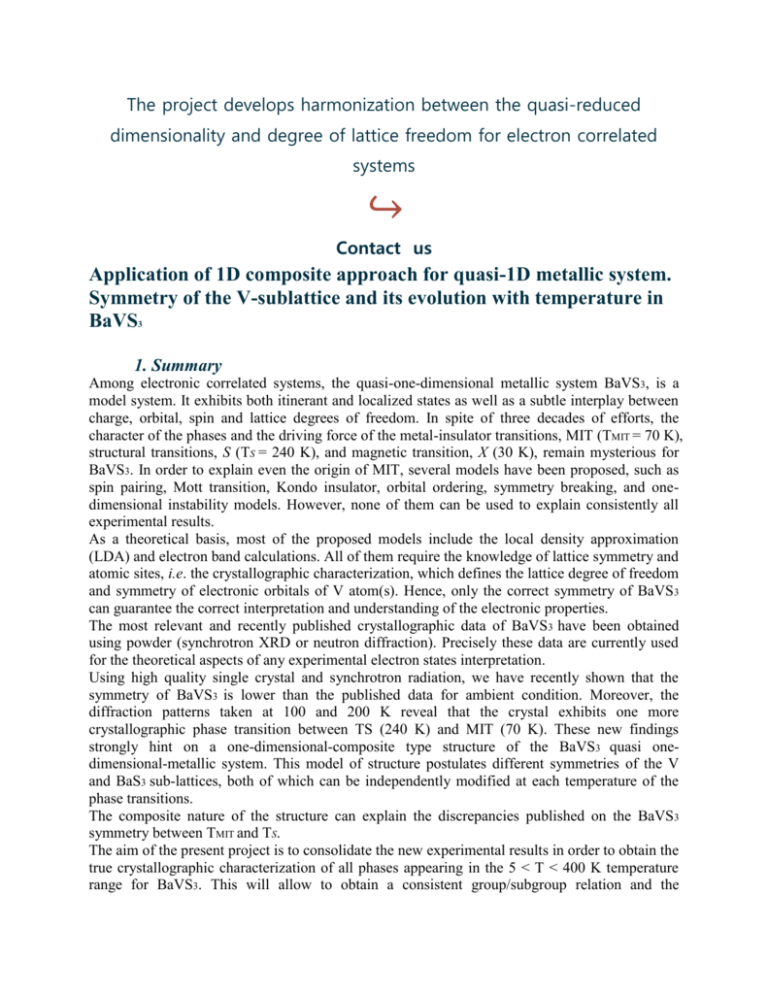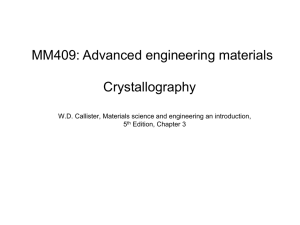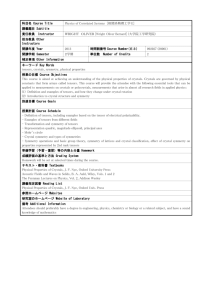Full text of the project is available here
advertisement

The project develops harmonization between the quasi-reduced dimensionality and degree of lattice freedom for electron correlated systems ↪ Contact us Application of 1D composite approach for quasi-1D metallic system. Symmetry of the V-sublattice and its evolution with temperature in BaVS3 1. Summary Among electronic correlated systems, the quasi-one-dimensional metallic system BaVS3, is a model system. It exhibits both itinerant and localized states as well as a subtle interplay between charge, orbital, spin and lattice degrees of freedom. In spite of three decades of efforts, the character of the phases and the driving force of the metal-insulator transitions, MIT (TMIT = 70 K), structural transitions, S (TS = 240 K), and magnetic transition, X (30 K), remain mysterious for BaVS3. In order to explain even the origin of MIT, several models have been proposed, such as spin pairing, Mott transition, Kondo insulator, orbital ordering, symmetry breaking, and onedimensional instability models. However, none of them can be used to explain consistently all experimental results. As a theoretical basis, most of the proposed models include the local density approximation (LDA) and electron band calculations. All of them require the knowledge of lattice symmetry and atomic sites, i.e. the crystallographic characterization, which defines the lattice degree of freedom and symmetry of electronic orbitals of V atom(s). Hence, only the correct symmetry of BaVS 3 can guarantee the correct interpretation and understanding of the electronic properties. The most relevant and recently published crystallographic data of BaVS3 have been obtained using powder (synchrotron XRD or neutron diffraction). Precisely these data are currently used for the theoretical aspects of any experimental electron states interpretation. Using high quality single crystal and synchrotron radiation, we have recently shown that the symmetry of BaVS3 is lower than the published data for ambient condition. Moreover, the diffraction patterns taken at 100 and 200 K reveal that the crystal exhibits one more crystallographic phase transition between TS (240 K) and MIT (70 K). These new findings strongly hint on a one-dimensional-composite type structure of the BaVS3 quasi onedimensional-metallic system. This model of structure postulates different symmetries of the V and BaS3 sub-lattices, both of which can be independently modified at each temperature of the phase transitions. The composite nature of the structure can explain the discrepancies published on the BaVS3 symmetry between TMIT and TS. The aim of the present project is to consolidate the new experimental results in order to obtain the true crystallographic characterization of all phases appearing in the 5 < T < 400 K temperature range for BaVS3. This will allow to obtain a consistent group/subgroup relation and the corresponding correlations with the published experimental properties in this temperature range. The proper symmetry of the V and BaS3 sub-lattices will give a sound crystallographic basis for theoretical considerations of electron states. The composite structure approach can very probably be generalized for some other systems with reduced dimensionality. Therefore, the proposed project can further assist any study of cooperative spin, charge, and orbital correlations with reduced dimensionality. 2. Research plan 2.1. State of research in the field In materials with correlated electrons, the interaction between spin, charge, orbital, and lattice degrees of freedom leads to a wealth of ordering phenomena and complex phases [1]. Correlated electron systems with metal-insulator transitions (MIT) accompanied by Mott localization and charge ordering are well known for complex electronic systems involving multiple orbitals. They notoriously tend to create complex structural distortions and lower symmetry. It is therefore of capital importance to perform studies on the relation of structural and electronic degrees of freedom. In this context, the quasi-one-dimensional metallic system BaVS3 is a fascinating example [2]. Among correlated electronic systems, BaVS3, which exhibits both itinerant and localized states as well as a subtle interplay between charge, orbital, spin and lattice degrees of freedom, is a model system. Its electronic structure consists in a broad quasi–one-dimensional (1D) dz2 band and two quasi-degenerate narrow e(t2g) bands [3]. Four temperature dependent crystallographic modifications have been reported for BaVS3 [4- 7]. According to all published data, the hexagonal structure with space group P63/mmc is stable at room temperature (Fig. 1). Fig. 1 Schematic structure of BaVS3 at room temperate. The orthorhombic unit cell is indicated by solid line. The V-V distance is roughly 2.8 Å along the V-chain, while the V-V distance is 2.4 times longer between the V-chains. By decreasing temperature, three successive phase transitions have been reported for BaVS 3: first, a second-order structural phase transition occurs at TS 240 K with orthorhombic space group Ccm21 [5-7] or Ccmm [4]; second, a metal-insulator transition (MIT) occur at TMI = 70 K accompanied by a symmetry lowering to a monoclinic phase with space group Im [5-7] or orthorhombic sp. gr. Im2m [4]; third, a magnetic ordering takes place for T <!TX = 30 K. While NMR/NQR measurements have failed to detect any magnetic order below TX, a neutron scattering study has provided evidence for an incommensurate magnetic order with the propagation vector q = (0.226, 0.226, 0.033)H in the hexagonal setting. According to the q-vector, the symmetry of the phase below TX has to be given in terms of a (3+2)D superspace group. However, we did not find such any available information in literature. No structural modulations have been detected in the lower temperature phase down to 5 K. Fig. 2 summarizes the state-of-art on the symmetry of BaVS3 at different temperatures. It should be mentioned that numerous studies claiming space group Ccm21 between TS and TMIT were based on powder synchrotron XRD, while space group Ccmm has been derived [4] using single crystal XRD. These measurements have to be taken seriously. Concerning the symmetry of the phase between TMIT and TX, the monoclinic space group Im seems to be more probable. Fig. 2 Temperatures of phase transitions and space groups of the metal and insulator BaVS3 phases according to published data. In spite of four decades of efforts, the character of the phases and the driving force of MIT remain mysterious. In order to explain the origin of the metal-insulator transition of BaVS3, several models have been proposed, such as spin pairing [8], Mott transition [9], Kondo insulator [10], orbital ordering [2,11,12], symmetry breaking [2], one-dimensional charge density wave instability models [13, 14] and a lattice fermion model [15]. However, none of them can be used to explain all experimental results consistently. One of the most disscussed problem of MIT concerns the degeneration of the quasi–onedimensional dz2 (A1g) and two quasi-degenerate e(t2g) (Eg) states. The reason of MIT is frequently associated with the splitting of the A1g electron orbital which is confirmed by the orthorhombic (Ccm21) to monoclinic (Im, cM = 2cH) structural transition accompanied by a four-fold splitting of the V-V distance values in the V-chain. However, the recently published [16] angle-resolved photoemission spectroscopy (ARPES) observation shows that an energy gap is formed in the A1g band prior to MIT, namely between 120 and 150 K. The phase transition at 130 K can be also inferred from the electrical resistivity observations (Fig. 3 according to [17]). Another experimental evidence of the phase transition at about 130 K can be seen from the Raman spectra measurements (Fig. 4 after [2]). Indeed, the Raman response Im with in-chain polarization at 210 K is dramatically different from that at 80 K, while the response at 130 K seems to correspond to two-phase sample. Neither crystallographic nor symmetry published information can fit these observations. Fig. 3. The resistivity of BaVS3 above 100 K. The structural phase transition S has been identified in [17] with TS = 240 K (solid vertical line). One more phase transition can be inferred at 130 K (red dashed line). Fig. 4 after [2]. Temperature dependence of the Raman response Im with in-chain polarization. The dashed lines are the scattering background. The data are systematically shifted and multiplied by the given factor. The Raman response at 210 K is very different from that at 80 K, while the response at 130 K seems to correspond to two-phase sample. Most of the proposed models include the local density approximation (LDA) and electron band calculations as a theoretical basis. All of them require the lattice symmetry and atomic sites, i.e. the crystallographic characterization, which defines the lattice degree of freedom and symmetry of the electronic orbitals of V atom(s). Hence, only the correct symmetry of BaVS 3 can guarantee a correct understanding and interpretation of the electronic properties. All the theoretical aspects of the experimental electron states interpretation have been done using the hexagonal space group P63/mmc at ambient condition and orthorhombic space group Ccm21 for the phase between TS and TMIT (70 < T < 240 K). However, there is no unequivocal experimental justification of the symmetry at 70 < T < 240 K (Table 1). In addition, no high quality single crystal synchrotron XRD study have ever been published for the phase at ambient condition. Unlike previous studies, we used both a high quality single crystal and synchrotron XRD experiments in our preliminary experimental data obtained at 100, 200 and 295 K. The experimental data show that the symmetry of BaVS3 is lower than the published results at ambient condition. Moreover, the experimental measurements taken at 100 and 200 K indicate that the crystal exhibits one more crystallographic phase transition between TS (240 K) and TMIT (70 K). These new findings give us strong hints on the one-dimensional- composite type structure of the BaVS3 quasi one-dimensional-metallic system. This type of structure assumes different symmetries for the V and BaS3 sub-lattices, both can change independently from each other at the phase transitions temperatures. The one-dimensional composite (or host-guest) character is well known for most simple metals at high pressure [18,19]. The structure of Ba-IVa is shown in Fig. 5a as an example and in comparison with BaVS3 in a similar structure representation. Fig. 5a (after [18]) (a)Structure of Ba-IVa shown in projection down the c-axis. The host atoms, in layers at z = 0 and 0.5, are shown with light grey shading while the guest atoms chains with dark grey shading. Perspective views of the coexisting (b) monoclinic and (c) tetragonal guest structures in Ba-IVa. Fig. 5b Left: BaVS3 structure shown in projection down the c-axis. The host atoms of the BaS3 sub-lattice (layers at z = 0 and 0.5,) are shown with yellow and grey colors. The guest atoms chains are indicated in blue color. Right: a perspective view of the guest, V sub-lattice. We previously applied this approach to improve the description of a crystal structure and electrical and magnetic properties of beta-Ta [20,21]. It appears that the one-dimensional composite structure approach can explain the discrepancies published on the BaVS3 symmetry between TMIT and TS. Thus, the use of the composite structure approach can essentially give a unified model for the crystallographic characterisation of all phases appearing in the 5 < T < 400 K temperature range for BaVS3. The new interpretation will give a sound basis for theoretical electron state considerations in order to assist the modelling of systems with reduced dimensionality. 2.2. Background of the applicant 2.2.1 Experimental synchrotron XRD data Using high quality single crystal and synchrotron radiation we obtained the following experimental results for BaVS3: 1.The hexagonal structure is confirmed at 295 K. However, the conventional space group P63/mmc is violated by 00l and hhl (l = 2n+1) reflections at room temperature (Fig. 6). Fig. 6. The hk3 plane in the reconstructed reciprocal space of BaVS3 at 295 K. Red circles show the hh3 and 003 reflections, which violate the P63/mmc space group. 2. At 200 K, all reflections exhibit a 3-fold split. This point to the group/subgroup index 3 between space group at 295 and 200 K, i.e. the structural transition S has index 3. The structure looses its 3-fold axis by decreasing temperature at TS = 240 K. 3. At 100 K, all reflections indicate a 6-fold split. This point to one additional phase transition between 100 and 200 K. this is in agreement with the observations (Fig. 3,4) reported in [2,16,17]. This transition, S’, exhibits a group/subgroup index of 2 in comparison to phase at 200 K, and an index of 6 in comparison to the phase at 295 K. 4. The synchrotron XRD data obtained at 295 K after cooling indicate reversibility of all the phase transitions. Fig. 7 illustrates the experimental synchrotron XRD data pointing to one additional phase transition between 200 and 100 K. The published T-dependence of the electrical resistivity and the magnetic susceptibility are also shown in the figure. Fig. 7. Evolution of the (600) reflection between 100 and 295 K. At 200 K, the 3-fold splitting points to index 3 of the S transition at TS. At 100 K, the 6-fold splitting points to index 2 for an additional phase transition in the range 100 < T < 200 K. 2.2.2. Interpretation of the synchrotron XRD experiments The classical approach of the crystallographic characterization The phase at 295 K. Taken into account the reflections violating space group P63/mmc, the crystal structure has been successfully refined in the subgroup P-6m2 (R-index = 3.5%). It should be mentioned that the refinement in the published space group P63/mmc is possible and indeed leads to a reasonable result at the cost of ignoring the extra reflections, which are about 10% of all reflections. The phase at 200 K. According to the experimental evidence, which points to the group/subgroup index 3, the only possible subgroup of P-6m2, namely Cm2m, can be postulated for the structure at 200 K. In this space group one site of sulfur is split into 4 inequivalent positions, and one site of Ba is split into 2. The refinement (R = 3.8%) reveals high correlations among S and Ba sites, what points to symmetrical dependence among S and between Ba sites. Refinement in the published Ccm21 space group shows a much better reliability R = 1.9% with atomic parameters identical to previously published studies. However, the presence of the 00l (l = 2n+1 = 3, 5, 7) reflections must be ignored in this space group, what is possible, but probably not correct. It is exactly this reason invoked by the authors of [4] to reject Ccm21 space group and consider Ccmm. All recent publications never mentioned any analysis of the XRD data at room temperature. Our data uniquely point to P- 6m2, but neither Ccm21 nor Ccmm are subgroups of P-6m2, therefore, they cannot be considered as correct. Here we meet contradictions between the XRD experimental evidences and group/subgroup relations. The phase at 100 K. According to the experimental evidence, which points to a group/subgroup index 2 relative to the orthorhombic phase at 200 K, the monoclinic space groups C2 and Cm have to be considered. The best results of refinement have been reached with space group Cm (reliability index R = 2.6%). Using the published orthorhombic space group Ccm21 for this temperature, we reached also good a reliability R = 2.8%, however, weak but well resolved 00l (l = 2n+1 = 3, 5, 7) reflections are incompatible with this group. Thus, with the structure refinements obtained in the classical approach of crystallographic characterization, the following results have been reached: (i)The published results have been confirmed with the cost of ignoring of extra reflections; (ii)One more phase transition from orthorhombic (at 200 K) to monoclinic (at 100 K) phase has to be postulated to fit the experimental observations, which have been published but not discussed in [2, 16, 17]. In parallel, the classical approach of the crystallographic characterization fails to interpret the group/subgroup relations between phases stabilized at 295, 200 and 100 K. The one-dimensional composite approach of the crystallographic characterisation A plausible explanation of the XRD experiments and the structure refinements can be reached by interpreting the structure in terms of a one-dimensional composite structure. Composite structures are part of the more general class of aperiodic structures which can be commensurate or incommensurate. In the case of BaVS3 structure behaves as a commensurate composite consisting of two components, V and BaS3. The highest symmetry of BaS3 is P63/mmc, i.e. it is identical to the one published for the BaVS3 compound. However, thehighest symmetry of the V-component is P6/mmm. Each component has its own symmetry, which behaves independently during phase transitions. This is a typical behavior for a composite structure and it is its most important property. The strong difference between the V-V and the V-S interactions is based on chemical considerations. The 1D composite structure gives a sound justification of the crystallographic behavior of the quasi 1D metal properties of BaVS3. One of schemes, which can be proposed for the group/subgroup relations, is shown in Fig. 8 for both V and BaS3 sub-lattices in comparison to the published data. Fig. 8. Group/subgroup relations in the classical and the one-dimensional composite approach. As can be deduced from the Fig. 8, the published structural data essentially correlate with the BaS3-component. The weak XRD reflections violating the traditional space groups can be simply attributed to the V-component. This is not surprising because the 56 + 16x3 = 104 electrons of BaS3 () give the main contribution for the X-ray diffraction in comparison to the 23 electron of V. Only synchrotron radiation applied to a single crystal is able to reveal those weak reflections in our experiments. The proposed scheme (Fig. 8) is highly probable but it is one among others, which have to be tested with the corresponding structure refinements. Fig. 9 represents one among several possible schemes of the V site(s) characteristics, which can be derived from the scheme shown in Fig. 8. Fig. 9. One among several possible schemes of the V site(s) characteristics, which can be derived from the scheme shown in Fig. 6. The number of vibrational degrees of freedom corresponds to the harmonic approximation of the V atom displacement. The V sites characteristics correspond to the published crystallographic data are shown for comparison. Confirmations of the one-dimensional composite approach (i)The one-dimensional composite approach can fit the whole set of the XRD data including extra reflections, while the classical approach fails with to interpret the group/subgroup relations between the phases at 295, 200 and 100 K. (ii)This approach can explain the various published models pertaining to the BaVS3 symmetries between TMIT = 70 K and TS = 240 K. (iii)This approach explains the experimental observations (which have been reported but have not been discussed in [2,16,17]) by one more phase transition occurring between 100 and 200 K. Open questions (i) As mentioned above, more than one possible scheme can be proposed for the phase transformations in the 100 - 295 K temperature range. In order to select the right version, all of them have to be tested with structure refinements on the basis of synchrotron XRD experiments. (ii) The results have to be confirmed with additional experiments obtained at about 400 K (phase with the highest symmetry) and in the vicinity of TMIT = 70 (or 69) K. (iii) The new structural approach can correct the symmetry analysis at temperatures lower than TMIT. Hence, synchrotron XRD experimental data at 65, 40, 25 and 5 K are needed in order to complete the crystallographic information. 2.3. Detailed research plan 2.3.0. The main goals and expected results This project will provide the correct and relevant crystallographic data concerning BaVS3 in the 5 – 400 K temperature range. Unlike previous studies, we will use a high quality single crystal for the synchrotron XRD experiments. Our preliminary experimental data obtained at293, 200 and 100 K justify the proposed 1D-composite approach in order to fit the observations and to explain some contradictory results published in the symmetry analysis. The aim of the project is to develop the preliminary results. We expect to obtain fully characterized crystal structures in the 5 – 400 K temperature range, which will help us to establish the group/subgroup relations and the corresponding correlations with the published experimental properties in this temperature range. 2.3.1. Selection of the most relevant scheme of the V- and BaS3 sub-lattices transformation in the 100 - 295 K temperature range On the basis of the data already obtained at 295, 200 and 100 K for two different single crystals, 8 versions of the V- and BaS3 sub-lattices space group combination have to be tested for each crystal. The corresponding 16 structure refinements should yield the best scheme of the phase transformation in the 100 – 295 K temperature range. The selected version has to be validated by studies of the structure at T = 400 K (the highest symmetry of both sub-lattice is expected) and at the temperature around TS = 240 K. The powder synchrotron XRD experiments will be also carried out in order to obtain correct lattice constants at 100, 200, 240, 295 and 400 K. This part of study will takes about 4 – 5 months followed by the first publication of the obtained results. 2.3.2. Structural study around TMIT = 70 K The single crystal diffraction patterns and evolution of 2 single reflections have been reported [13] for BaVS3 in the vicinity of TMIT = 70 (or 69) K. However, the flux and resolution of the Xray beam are too low for laboratory diffractometers to observe a splitting of the main reflections and to detect extra reflections. In addition, the crystal structure refinement has never been reported in the vicinity of TMIT = 70 (or 69) K. The well-recognized minimum of the electrical resistivity observed at 130 K (Fig. 7, 8) is usually associated with a pre- transition structure fluctuation rather than with one more phase transition. This can be inferred from the experimental observation (Fig. 3, 4) [2, 16, 17] and from our experimental data at 100 and 200 K. The structural studies on the basis of the single crystal synchrotron XRD experiments (SNBL, Grenoble) obtained in the vicinity of TMIT = 70 (or 69) K (i.e. at 65, 69 and 70, 75 K) are planed to be preformed within the next two months. The corresponding results will be part of a second publication. 2.3.3. Structural study at the 5 – 70 K temperature range The new structural approach can correct the symmetry analysis at temperatures lower than TMIT. Taking into account the magnetic phase transition at TX = 30 K accompanied by the incommensurate magnetic ordering [22], the structural studies on the basis of the synchrotron XRD experiments (SNBL, Grenoble) obtained at 60, 40, 25 and 5 K is required in order to complete the crystallographic information. This part of the project is expected to be performed during the last 3 months of the project duration. 2.4. Timetable The program described in 2.3.1. is expected to be performed during the first 4 – 5 months of the project. The program described in 2.3.2. will last 3 months. The program described in 2.3.3. will be completed during the last 4 months. 2.5. The significance of the planed research to the scientific community and to eventual potential users Using the one-dimensional composite approach, the aim of the planed research is to obtain a consistent model for the crystallographic characterization of the one-dimension metal BaVS3 in the 5 – 400 K temperature range. This will give a solid crystallographic basis to model the electronic states and improve our understanding of correlated electronic systems. The electronic state of BaVS3 is currently intensively studied experimentally in the 5 – 300 K temperature range. The interpretation of the measured electronic properties needs theoretical considerations, which require crystal structure data (symmetry, position and vibration parameters of all atomic sites consisting the structure). Hence, the correct interpretation of the electronic state experimental data can only be guaranteed provided consistent crystallographic models, which are currently lacking for BaVS3. The obtained data will essentially help to study the BaVS3 behavior not only at high pressure but also by combining high pressure and low temperature. The composite structure approach can possibly be generalized for some other systems with reduced dimensionality. Therefore, the study of the proposed project can essentially assist further studies of cooperative spin, charge, and orbital correlations with reduced dimensionality. 3. Literature [1] I. Leonov, N. Binggeli, Dm. Korotin, V. I. Anisimov, N. Stojic, and D. Vollhardt Structural Relaxation due to Electronic Correlations in the Paramagnetic Insulator KCuF3 Phys. Rev. Lett. 096405 (2008). [2] K.-Y. Choi, D. Wulferding, H. Berger, and P. Lemmens. Interplay of electronic correlations and lattice instabilities in BaVS3 Phys. Rev. B 80, 245108 (2009). [3] S. Bernu, P. Foury-Leylekian, P. Fertey, F. Licci, A. Gauzzi, A. Akrap, H. Berger, L. Forró and J.-P. Pouget. Charge ordering in substituted and non-stoichiometric BaVS3. EPL (Europhysics Letters) 89 27006 (5pp), 2010. doi:10.1209/0295-5075/89/27006. [4] T. Inami, K. Ohwada, H. Kimura, M. Watanabe, Y. Noda, H. Nakamura, T. Yamasaki, M. Shiga, N. Ikeda, and Y. Murakami. Symmetry breaking in the metal-insulator transition of BaVS3. Phys.Rev. B 66, 073108 (2002). [5] S. Fagot, P. Foury-Leylekian, S. Ravy, J.P. Pouget, M. Anne, G. Popov, M.V. Lobanov, M. Greenblatt Structural aspects of the metal-insulator transition in BaVS3 Solid State Science 7 (2005) 718. [6] M. Ghedira, M. Anne, J. Chenavas, M. Marezio and F. Sayetat. Powder neutron diffraction studies of the low- temperature phase transitions in stoichiometric BaVS, J. Phys. C: Solid State Phys. 19 (1986) 6489-6503. [7] Ph. Leininger, V. Ilakovac, Y. Joly, E. Schierle, E. Weschke, O. Bunau, H. Berger, J.-P. Pouget, and P. Foury- Leylekian. Ground State of the Quasi-1D Compound BaVS3 Resolved by Resonant Magnetic X-Ray Scattering. PRL 106, 167203 (2011). [8] H. Nishihara and M. Takano, J. Phys. Soc. Jpn. 50, 426 (1981). [9] M. Nakamura, A. Sekiyama, H. Namatame, A. Fujimori, H. Yoshihara, T. Ohtani, A. Misu, and M. Takano, Phys. Rev. B 49, 16191 (1994). [10] T. Graf, D. Mandrus, J. M. Lawrence, J. D. Thompson, P. C. Canfield, S.-W. Cheong, and L. W. Rupp, Phys. Rev. B 51, 2037 (1995). [11] G. T. Mihály, I. Kezsmárki, F. Zámborszky, M. Miljak, K. Penc, P. Fazekas, H. Berger, and L. Forró, Phys. Rev. B 61, R7831 (2000). [12] H. Nakamura, H. Imai, and M. Shiga, Phys. Rev. Lett. 79, 3779 (1997). [13] S. Fagot, P. FouryLeylekian, S. Ravy, J. -P. Pouget, and H. Berger, Phys. Rev. Lett. 90, 196401 (2003). [14] Daniel Grieger, Lewin Boehnke and Frank Lechermann. Electronic correlations in vanadium chalcogenides: BaVSe3 versus BaVS3. J. Phys.: Condens. Matter 22 (2010) 275601. stacks.iop.org/JPhysCM/22/275601. [15] P. Fazekas, K. Penc, K. Radnoczi, N. Barisic, H. Berger, L. Forro, S. Mitrovic, A. Gauzzi, L. Demko, I. Kezsmarki, G. Mihaly. The electronic structure and the phases of BaVS3. Journal of Magnetism and Magnetic Materials 310 (2007) 928–934. [16] H. Sato, K. Tobimatsu, A. Tanaka, H. Nakamura, H. Hayashi, J. Jiang, T. Habuchi, D. Hirayama, H. Iwasawa, K. Shimada, M. Arita, M. Nakatake, H. Namatame and M. Taniguchi. Angle-Resolved Photoemission Study on Quasi- One- Dimensional BaVS3. Thesis of SCES 2011 conference (October 2011). [17] H. Kuriyaki, H. Berger, S. Nishioka, H. Kawakami, K. Hirakawa and F. A. Léy. Synthesis and characterization of BaVS3 single crystals grown in melted Te. Synthetic Metals, 71 (1995) 2049-2050. [18] Malcolm I. McMahon and Richard J. Nelmes. High-pressure structures and phase transformations in elemental metals. Chem. Soc. Rev., 2006, 35, 943–963. [19] Malcolm I. McMahon & Graeme J. Ackland. Aluminium: Simple metal no more. Nature Materials 9, 607–608 (2010). doi:10.1038/nmat2817. [20] Arakcheeva A, Chapuis G, Grinevitch V. The self-hosting structure of beta-Ta. Acta Cryst., 2002, B58, 1-7. [21] A. Arakcheeva, G. Chapuis. Atomic Clusters and Phase Transitions in the Metastable β-Ta Phase between 4.2 and 293 K. Europhysics Letters, 2005, 69(3), 378-384 [22] H. Nakamura, T. Yamasaki, S. Giri, H. Imai, M. Shiga, K. Kojima, M. Nishi, K. Kakurai and N. Metoki. Incommensurate Magnetic Ordering and Spin-Liquid-Like State in a Triangular Lattice BaVS3: Neutron Diffraction and Scattering Study. Journal of the Physical Society of Japan. 69, 9 (2000) 2763-2766.









